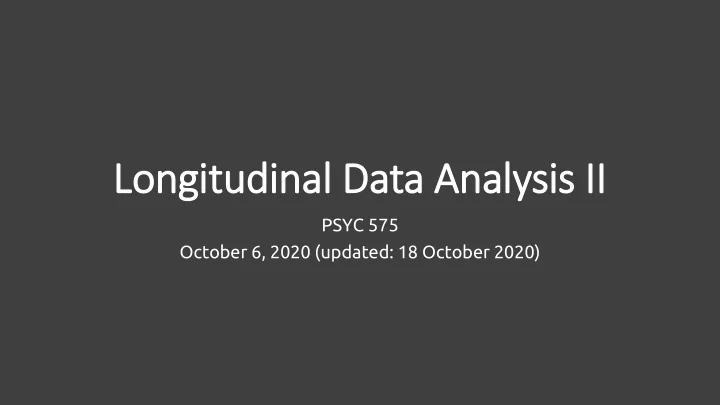

Longitudinal Data Analysis II II PSYC 575 October 6, 2020 (updated: 18 October 2020)
Learning Objectives • Describe the difference between analyzing trends vs. analyzing dynamics with longitudinal data • Run analyses with time-varying predictors (i.e., level-1 predictors) • Interpret and plot results
Example
The Cognition, , Health, , and Aging Project • The first wave of the CHAP • Six observations over a two-week period • Sessions 2-6 • baseage : M = 80.13 ( SD = 6.11)
Time-Vary rying Covariates • Variables at the within-person level that changes over time • Need cluster-mean/person-mean centering • Between-person/within-person effects • Symptoms : Number of physical symptoms in the past 24 hours • Max = 5 • Mood : Daily report negative mood (1 – 5) • Mood1 : center at 1 (0 – 4) • Stressor: Presence of a daily stressor (0 = stressor-free day; 1 = stressor day)
Decomposition of f Effects • Very important for some variables with longitudinal data • But not for the “time” variable • May not be meaningful for other measures of time (e.g., age) • Trait: Person mean, time-invariant (in some sense) • State: Deviation (fluctuation) from person mean, time-varying
Describing Fluctuations • TIME may not be a predictor (unless a stable trend is expected) • The interest is in the momentary changes
Model 1
Model Equations
Fixed Effects (w (with brms ) Estimate Est.Error l-95% CI u-95% CI Rhat Bulk_ESS Tail_ESS Intercept 0.85 0.25 0.35 1.34 1.00 566 1119 mood1_pm 3.89 0.83 2.22 5.52 1.00 639 1101 mood1_pmc 0.02 0.29 -0.56 0.58 1.00 1713 2261 womenwomen -0.03 0.29 -0.58 0.54 1.00 566 1183 mood1_pm:womenwomen -2.15 0.91 -3.87 -0.31 1.00 655 1189 mood1_pmc:womenwomen 0.15 0.33 -0.52 0.80 1.00 1681 2128 Note the between-person and the within-person effects are drastically different
conditional_effects(m1)
Between/Within Effects
Model 2
Add stressor to the Equation • A time-varying binary variable • stressor_pm (person mean): Average stress level of a person (over the study period) • However, the deviation from the person mean is harder to interpret • E.g., stressor_pmc = 0.8? • Methodologists do not agree how to treat it, but for this example we’ll keep the binary lv -1 variable • ➔ Contextual & within-person
Context xtual and Within-Person Effects
Context xtual Effect Population-Level Effects: Estimate Est.Error l-95% CI u-95% CI Rhat Bulk_ESS Tail_ESS ... stressor_pm 0.88 0.30 0.28 1.46 1.00 992 1343 stressorstressorday 0.06 0.10 -0.13 0.26 1.00 3029 3013 • On a stressor day (or a stressor-free day), a person who is one unit higher on average stress level reported on average 0.88 more symptoms, 95% CI [0.28, 1.46].
Topics Not Covered • Comparable metric across time • Vertical scaling/Longitudinal measurement invariance • Lag relationship/cross-lagged/autoregressive model (but see the bonus handout) • Parallel-process model • Missing data handling • Multiple cohort design
Recommend
More recommend